UCSB Hist 133C,
L 19:
Dissent in West Germany
by Prof. Marcuse, Feb. 20, 2004
What role did/does public protest play in the creation and character of
a democratic society?
- West Germany: conformist & repressive
- West Germany: hotbed of dissent
- Q7 and discussion of Schneider
- midterm evaluation
What does Germany stand for? How did Germany go from the one image to the other
(or: is it both at once)?
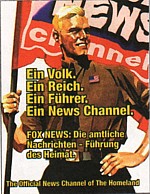 |
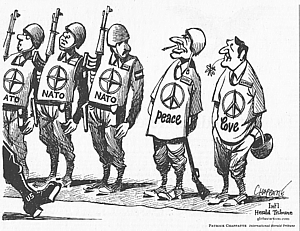 |
Germany: stereotypical country that falls into line
(cover of The Nation, April 2003)
|
West Germany: the country that falls out of line (the last
2 are Chirac and Schroeder)(Intl Herald Tribune, Feb. 2003)
See Foreign Minster Fischer's 3/19/03 statement against US military intervention
in Iraq (link)
|
West Germany: Conformist
- Adenauer:
- father-figure
- obedient to West
- 50s "Economic Miracle": materialism
- Renazification
- Remilitarization (banning of KPD, 1956)
West Germany: Radical
- Long tradition of dissent
- pre-World War I : SPD success as reason for war in 1914!
- Nazism as the ultimate radical movement; but: radical means of restoring
"the old"
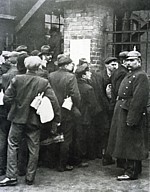 |
 |
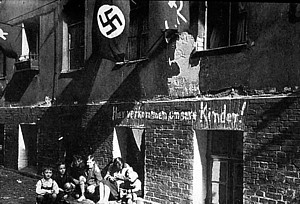 |
|
1912 miner's strike in the Ruhr -- tradition of radical
worker agitation |
1912 miner's strike in the Ruhr: put down by police
-- in the authoritarian tradition |
1932 rent strike in Berlin:
The Nazis were as radical as the communists
|
Dissent in 1947
|
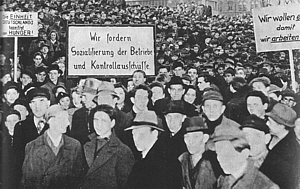
Demonstration demanding the socialization of factories in the Ruhr (above)
student demonstration in Munich (right)
|
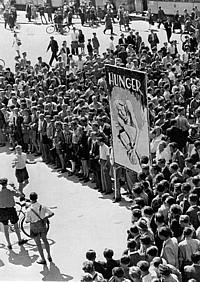 |
Dissent in 1953 (East!): June uprising
Dissent in 1955: anti-remilitarization
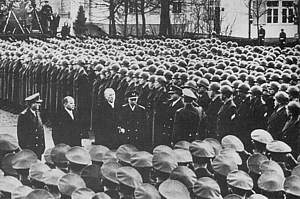 |

Three images from 1955: swearing in of the first Bundeswehr recruits;
anti-remilitarization protest with Adenauer quote "I'm proud
never to have been a soldier;"
Pankok's famous image of Christ breaking a rifle over his knee.
|
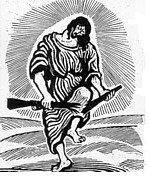 |
Anti-nuclear movement: 1958, 1979 Gorleben/1981 Brokdorf, 1983
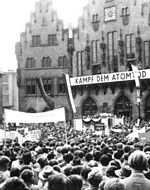 |
 |
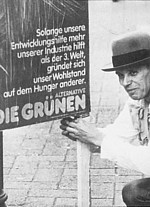 |
These five images show examples of the long-standing German
tradition of protest against nuclear power and armaments (clockwise):
Frankfurt, 1958
Gorleben, 1979
Beuys/Greens, 1980
Human chain, 1983
Brokdorf nuclear fortress
|
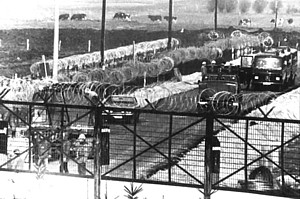 |
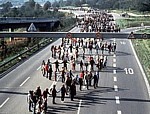 |
1962-63: Spiegel Affair
1968: Beginning of the "Long March through the Institutions"
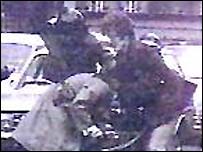 |
 |
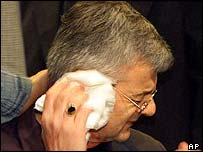 |
|
Joschka Fischer ca. 1968: caught on video slugging a policeman
|
Fischer in 1968 and 2003. He was a founding member of the
Green Party in late 1970s, became part of the Hesse government in 1985,
and became German foreign minister in 1998.
|
Fischer was hit by a demonstrator's paint balloon in 1999
because of his stance supporting armed intervention in Kosovo.
|
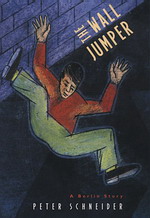 Schneider,
The Wall Jumper
Schneider,
The Wall Jumper
Q7: What point (thesis) is Schneider trying to make? (What evidence does
he muster?)
- 2 best answers:
- People growing up in Germany during division are deeply affected by
their respective governments and cultures. They view the exact same events
in very different ways. Schneider demonstrates this many times: When the
East and West television networks protray the same events, but have almost
conflicting portrayals. He and Robert argue a few times over politically
carged events and every time, they have different interpretations that
Schneider attributes to their upbringing. It is not that one side is "better"
or more correct, but it depends on what side of the wall you grew up on.
- I think Schneider's point is that the worldviews of East and West Germans
is shaped by which side of the wall they grew up on. Specifically, he
says the way they think & believe is shaped in opposition to the other
side. The love or allegiance for one's own side is based on a distaste
and disagreement with the other, if theirs is bad, ours must be good.
Each story he tells about people jumping the wall, such as Kabe or the
Willys, are about people seeking to define themselves outside of the state.
Schneider seeks to find a German identity that does not include E/W division.
- Discussion: What theses did YOU think?
- People were the same on both sides of wall
- People were different on each side of the wall
- "Where does the self end and the state begin?"
- Pick up paper drafts, old Q6s
page by H. Marcuse, prepared for web Feb. 20-22, 2004, link added 2/26/04
back to top, to UCSB Hist 133c
homepage











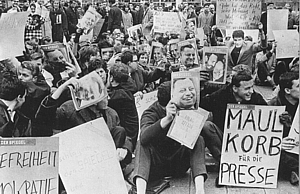
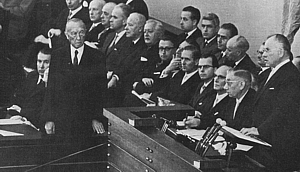



 Schneider,
The Wall Jumper
Schneider,
The Wall Jumper